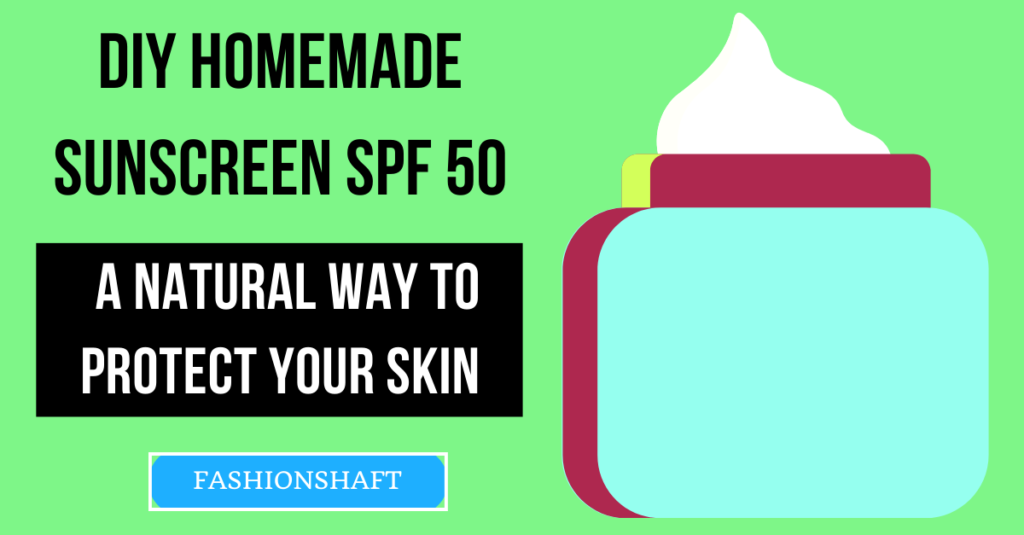DIY Homemade Sunscreen SPF 50: A Natural Way to Protect Your Skin
Introduction
In the quest for beautiful, sun-kissed skin, protecting it from harmful UV rays is paramount. While commercial sunscreens abound, there’s a rising interest in safer, chemical-free alternatives. Enter DIY Homemade Sunscreen SPF 50 – your ticket to effective and natural sun protection.
This article delves into the world of crafting your sunscreen, offering insights into the science of SPF, the advantages of going DIY, and a simple, step-by-step recipe. By the end, you’ll have the knowledge to create personalized, skin-loving sunscreen that keeps you safe while embracing the power of natural ingredients. Say goodbye to harsh chemicals and hello to a healthier way to shield your skin from the sun’s rays. Your skin deserves it!
The Science of SPF:

Before diving into the DIY sunscreen recipe, let’s take a moment to understand SPF. SPF, or Sun Protection Factor, is a crucial measure of a sunscreen’s effectiveness in shielding your skin from the harmful effects of ultraviolet (UV) radiation. UV radiation is responsible for sunburn, premature aging, and an increased risk of skin cancer.
The SPF number on sunscreen indicates how well it can protect your skin from UVB rays specifically – the rays responsible for sunburn. For instance, SPF 50 sunscreen filters out about 98% of UVB rays, while SPF 30 filters out about 97%. However, it’s important to note that no sunscreen can provide 100% protection.
Why Go DIY?
So, why should you consider making your sunscreen? There are several compelling reasons:
- Control over Ingredients: When you make your sunscreen, you have full control over the ingredients. You can choose natural, skin-friendly components and avoid potentially harmful chemicals commonly found in commercial sunscreens.
- Customization: DIY sunscreen allows you to customize the formula to suit your skin type and preferences. You can adjust the texture, scent, and even incorporate additional skincare ingredients like moisturizers or antioxidants.
- Eco-Friendly: Many commercial sunscreens contain chemicals that harm marine life and coral reefs when washed off in the water. Making your sunscreen allows you to use environmentally-friendly ingredients, reducing your impact on the planet.
- Cost-Effective: Over time, making your sunscreen can be more cost-effective than buying expensive commercial products.
A Simple Recipe for DIY Homemade Sunscreen SPF 50:

Now, let’s get to the fun part – making your sunscreen at home. This recipe is for a natural, SPF 50 sunscreen that’s easy to prepare. Here’s what you’ll need:
Ingredients:
- 1/4 cup coconut oil
- 1/4 cup shea butter
- 1/4 cup beeswax
- 2 tablespoons zinc oxide (non-nano, uncoated)
- 1 tablespoon carrot seed oil
- 1 teaspoon red raspberry seed oil
- 10-15 drops of your favorite essential oil (optional for fragrance)
- Small glass jars or tins for storage
Instructions:
- Prepare Your Work Area: Start by ensuring your workspace is clean and sterile. This is essential to prevent contamination of your homemade sunscreen.
- Combine Ingredients: In a heat-resistant glass container, combine the coconut oil, shea butter, and beeswax. Place the container in a double boiler or microwave and melt the ingredients together. Stir well to ensure they are thoroughly mixed.
- Add Zinc Oxide: Once the mixture is melted and well-mixed, carefully add the zinc oxide. Be cautious not to inhale the fine particles. Stir until the zinc oxide is fully incorporated into the mixture.
- Incorporate Oils: Remove the mixture from heat and add the carrot seed oil and red raspberry seed oil. These oils have natural sun-protective properties. If you desire a fragrance, add your favorite essential oil at this stage.
- Cool and Store: Allow the mixture to cool for a few minutes before pouring it into your small glass jars or tins. Let it cool completely before sealing the containers.
- Usage: Apply your DIY sunscreen liberally to exposed skin 15 minutes before sun exposure. Reapply every two hours or more frequently if swimming or sweating.
Conclusion
In a world where health-consciousness is on the rise, DIY Homemade Sunscreen SPF 50 offers a fantastic alternative to commercial sunscreens laden with chemicals. By understanding the science of SPF and the advantages of going the DIY route, you can take control of what goes on your skin while enjoying effective protection from the sun’s harmful rays.
This simple recipe empowers you to create a natural, eco-friendly sunscreen that caters to your specific needs and preferences. With the power of natural ingredients like coconut oil, shea butter, and zinc oxide, you can confidently bask in the sun’s warmth, knowing your skin is shielded in a healthier, more sustainable way. So, gather your ingredients, embrace your inner chemist, and give your skin the care it truly deserves. Enjoy the sunshine responsibly, naturally, and beautifully!

My name is Rohit Vagh and I’m a content writer specializing in fashion and lifestyle. I have three years of experience in this field and have written various articles. My writing style is creative and engaging, and I strive to create content that resonates with my readers. I have a deep passion for fashion and am constantly researching the latest trends and styles to make sure my readers are up to date. I’m excited to continue my career in blogging, and I’m always looking for new opportunities in the fashion and lifestyle space.





